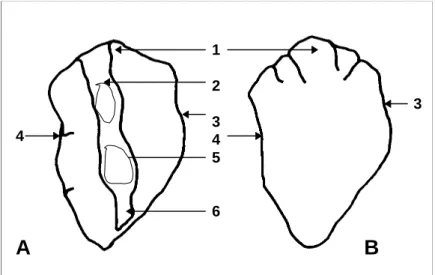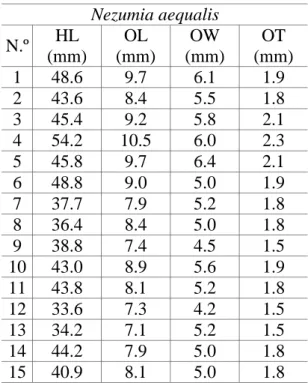Bol. Mus. Mun. Funchal, Sup. N.º 6: 205-212, 2001 ISSN 0870-3876
A USEFUL TOOL TO SPECIES IDENTIFICATION
AND ECOLOGYCAL STUDIES
By AFONSO MARQUES1 & ARMANDO J. ALMEIDA1With 2 figures, 2 tables and 1 plate
ABSTRACT. Otoliths of Nezumia sclerorhynchus and N. aequalis are described and compared. When studying the marine trophic relationships, its general shape and morphometry allows one to separated these two sympatric species.
KEY WORDS: Otoliths, Macrouridae, Nezumia sclerorhynchus, Nezumia aequalis.
RESUMO. São descritos e comparados os otólitos sagitta de Nezumia sclerorhynchus e de N. aequalis. No estudo das relações tróficas marinhas a sua forma e morfometria permitem distinguir qual destas duas espécies simpátricas foi predada.
PALAVRAS-CHAVE: Otólitos, Macrouridae, Nezumia sclerorhynchus, Nezumia aequalis.
1 IMAR, Faculdade de Ciências da Universidade de Lisboa, Departamento de Biologia Animal, Laboratório Marítimo da Guia, Estrada do Guincho, Forte N. Sr.ª da Guia, 2750-642 Cascais, Portugal.
INTRODUCTION
Teleost saccular otoliths have the potential for being among the most important available tools to researchers in ichthyology, fisheries biology, palaeontology, archaeology, and related disciplines.
From the ichthyologist point of view, the descriptive study of otoliths is important to estimate age and growth pattern of teleosts. The otoliths are the only structures that consistently record daily events in the early life stages and annual events
throughout life (JONES, 1992). They can also be useful regarding the trophic
relationships among aquatic communities, as the presence of these structures in the digestive tract is an important clue to prey identification. They can be also of great
help to establish relationships within gadiforms (NOLF & STEURBAUT, 1989) to which
the species studied herein belongs.
Nezumia sclerorhynchus (Valenciennes, 1838) and Nezumia aequalis (Günther,
1878) are sympatric species on the Portuguese slope and quite abundant (SALDANHA
et al., 1995) below 500 m (MARQUES & ALMEIDA, 1998). To determine which species is present in a predator stomach content, the general shape of the otolith can be used to identity these two species.
Otoliths of Nezumia aequalis, collected off Iceland, were described by SCHMIDT (1968).
In this work we describe Nezumia sclerorhynchus otoliths and compare its shape with that of Nezumia aequalis.
MATERIAL AND METHODS
Specimens were collected in December 1995 off the Portuguese west coast during the IPIMAR Cruise “Recursos de Profundidade”, at a depth of 870 m off Arrifana (37º 15’ N; 09º 15’ W). The material studied consisted of one hundred Nezumia
sclerorhynchus and fifteen N. aequalis captured on the same haul.
Otoliths were extracted from all the Nezumia aequalis (ranging from 33.6 mm to 54.2 mm head length) and from the sixteen larger Nezumia sclerorhynchus (ranging from 31.4 mm to 47.8 mm head length). They were cleaned from sacculus remains and observed under a stereomicroscope and a JEOL Scanning Electron Microscope LV-5200 (SEM).
The following measurements in millimetres, were taken using a calibrated stereomicroscope eyepiece: HL = head length of the fish; OL = otolith length; OW = otolith
width and OT = otolith thickness (SCHMIDT, 1968).
Ratios of selected measurements were calculated as follows: head length / otolith length; otolith length / otolith width and otolith length / otolith thickness, and their differences between Nezumia sclerorhynchus and N. aequalis were tested using
A B 1 2 3 4 5 6 3 4 A B 1 2 3 4 5 6 3 4
Fig. 1 Saccular otoliths of Nezumia sclerorhynchus (A inner face view of left sagitta; B -outer face view of right sagitta): 1 - rostrum; 2 - ostium; 3 - ventral margin; 4 - dorsal margin; 5 - sulcus; 6 - cauda. A B 1 2 3 4 5 6 3 4 A B 1 2 3 4 5 6 3 4
Fig. 2 - Saccular otoliths of Nezumia aequalis (A - inner face view of left sagitta; B - outer face view of right sagitta): 1 rostrum; 2 ostium; 3 ventral margin; 4 dorsal margin; 5 -sulcus; 6 - cauda.
RESULTS
Description of Nezumia sclerorhynchus saccular otolith:
This species has large otoliths (Fig. 1) as indicated by the mean HL/OL ratio 4.67. The outline is oval. Rostrum and antirostrum short and round. No excisura (deep sinus in the marginal outline where the sulcus ends anteriorly). The outer face is irregular and convex and the inner face is slightly convex. The dorsal margin is crenulated and less curved than the ventral margin. The highest point of the dorsal margin is the
anterodorsal dome. Outer face smooth. Ostium and cauda open. Sulcus extending full length of the otolith. Crista superior elevated and crista inferior slope shaped. Caudal colliculum plane (Plate I - A).
Otolith measurements (Table 1) are: Length (OL): 6.7 to 8.9 mm; Weight: 74.4 to 131.8 mg; Mean of HL/OL = 4.7 (ranging from 4.4 to 5.8); Mean of OL/OW = 1.8 (ranging from 1.6 to 2.0); Mean of OL/OT = 4.8 (ranging from 4.3 to 5.5).
Description of Nezumia aequalis saccular otolith:
This species has larger otoliths (Fig. 2) with a mean HL/OL ratio of 5.0. The outline is trapezoidal, the cranial end broad, with a short slightly rounded tip. Caudal end is thinner and ends up rounded. Antirostrum short and round having a slight excisura. The outer face is convex and the inner face flat. The highest point of the dorsal margin is the anterodorsal dome. Ostium open and cauda closed. Sulcus flat, extending full length. The ventral margin is almost even, but the caudal part can bear 1 to 3 little teeth. The dorsal margin is toothed strongly and more irregular (Plate I - B).
TABLE 1 - Meristic data, in millimetres, from Nezumia sclerorhynchus otoliths: HL - Fish
head length; OL - Otolith length; OW - Otolith width; OT - Otolith thickness.
Nezumia sclerorhynchus N.º HL (mm) OL (mm) OW (mm) OT (mm) 1 31.9 7.1 3.7 1.6 2 34.9 7.4 4.5 1.6 3 35.8 7.9 4.2 1.6 4 36.3 8.2 4.2 1.6 5 36.3 7.7 4.0 1.6 6 41.0 8.9 4.8 1.6 7 42.1 8.7 4.5 1.8 8 47.8 8.2 4.7 1.6 9 36.2 7.4 4.0 1.6 10 40.1 8.4 4.5 1.8 11 36.9 7.6 4.2 1.6 12 34.7 7.4 4.0 1.4 13 31.4 6.7 3.9 1.5 14 32.0 6.9 3.7. 1.6 15 38.7 8.4 4.7 1.8 16 39.7 8.4 4.7 1.6
TABLE 2 - Meristic data, in millimetres, from Nezumia aequalis otoliths: HL - Fish head
length; OL - Otolith length; OW - Otolith width; OT - Otolith thickness.
Nezumia aequalis N.º HL (mm) OL (mm) OW (mm) OT (mm) 1 48.6 9.7 6.1 1.9 2 43.6 8.4 5.5 1.8 3 45.4 9.2 5.8 2.1 4 54.2 10.5 6.0 2.3 5 45.8 9.7 6.4 2.1 6 48.8 9.0 5.0 1.9 7 37.7 7.9 5.2 1.8 8 36.4 8.4 5.0 1.8 9 38.8 7.4 4.5 1.5 10 43.0 8.9 5.6 1.9 11 43.8 8.1 5.2 1.8 12 33.6 7.3 4.2 1.5 13 34.2 7.1 5.2 1.5 14 44.2 7.9 5.0 1.8 15 40.9 8.1 5.0 1.8
Otolith measurements (Table 2) are: Length (OL): 7.1 to 10.5 mm; Weight: 95.6 to 309.5 mg; Mean of HL/OL = 5.0 (ranging from 4.3 to 5.6); Mean of OL/OW = 1.6 (ranging from 1.5 to 1.8); Mean of OL/OT = 4.7 (ranging from 4.4 to 5.1).
CONCLUSION
Morphologically, sagitta of both species can be easily distinguished by their general shape, as those of Nezumia sclerorhynchus are much more oblong, have no excisura and the ventral margin is serrated. However, the latter feature is age-related,
observed in juveniles of many macrourids (D. NOLF, pers. comm.).
The identification of these two species using the morphological shape of their otoliths is validated by the significant differences (t-test, P = 0.05) found for the OL/ OW and HL/OL relationships.
This method allows one to identify the otoliths eventually present in a predator stomach content, and to conclude which Nezumia species was preyed and even estimate its size.
Plate I - Scanning Electron Micrography of the left otoliths of Nezumia sclerorhynchus (A) and Nezumia aequalis (B) (x 1.500) (e = excisura). Scale bar = 1 mm.
A
B
e
A
B
e
Date received: 22-10-1998.
ACKNOWLEDGEMENTS
Authors are indebted to the late Professor Luiz Saldanha, Coordinator of the Mast Project MAS2 CT 920033, for his friendship and scientific guidance. Thanks are also due to former President of IPIMAR, Carlos Sousa Reis, the crew of the R/V “Noruega” and the Chief Scientist Maria José Figueiredo. The SEM was operated by Mónica Martins of the Centro de Biologia Ambiental (CBA), Faculty of Sciences of Lisbon. The authors thank Dr. D. Nolf for the valuable review of this paper and Mr. J. G. Quinn for revising the text. This work had the support of the EU MAS 2 CT 920033 Contract “Community structure and processes in the deep-sea benthos”.
REFERENCES
JONES, C. M.:
1992. Development and application of the otolith increment technique. In: Canadian Special Publication Fisheries and Aquatic Sciences (eds.: D. K. Stevenson & S. E. Campana), pp. 1-11. Otolith microestructure examination and analysis, 117: 1-11.
MARQUES, A. & A. J. ALMEIDA:
1998. Notes on the biology of Nezumia sclerorhynchus (Valenciennes, 1838) and Nezumia aequalis (Günther, 1878) (Pisces: Macrouridae) from the Algarve slope, northeast Atlantic. Cybium, 22 (2): 21-29.
NOLF, D. & E. STEURBAUT:
(?) Evidence from otoliths for establishing relationships within gadiforms. In: Papers on the systematics of gadiform fishes (ed.: D. Cohen), No 32. Science Series, Natural History Museum of Los Angeles County.
SALDANHA, L., A. J. ALMEIDA, F. ANDRADE & J. GUERREIRO:
1995. Observations on the diet of some slope dwelling fishes of southern Portugal. Internationale Revue der Gesamten Hydrobiologie, 80 (2): 217-234.
SCHMIDT, W.:
1968. Vergleichend morphologische Studie über die Otolithen mariner Knochenfische. Archiv für Fishereiwissenschaft, 19 (1): 1-96.


